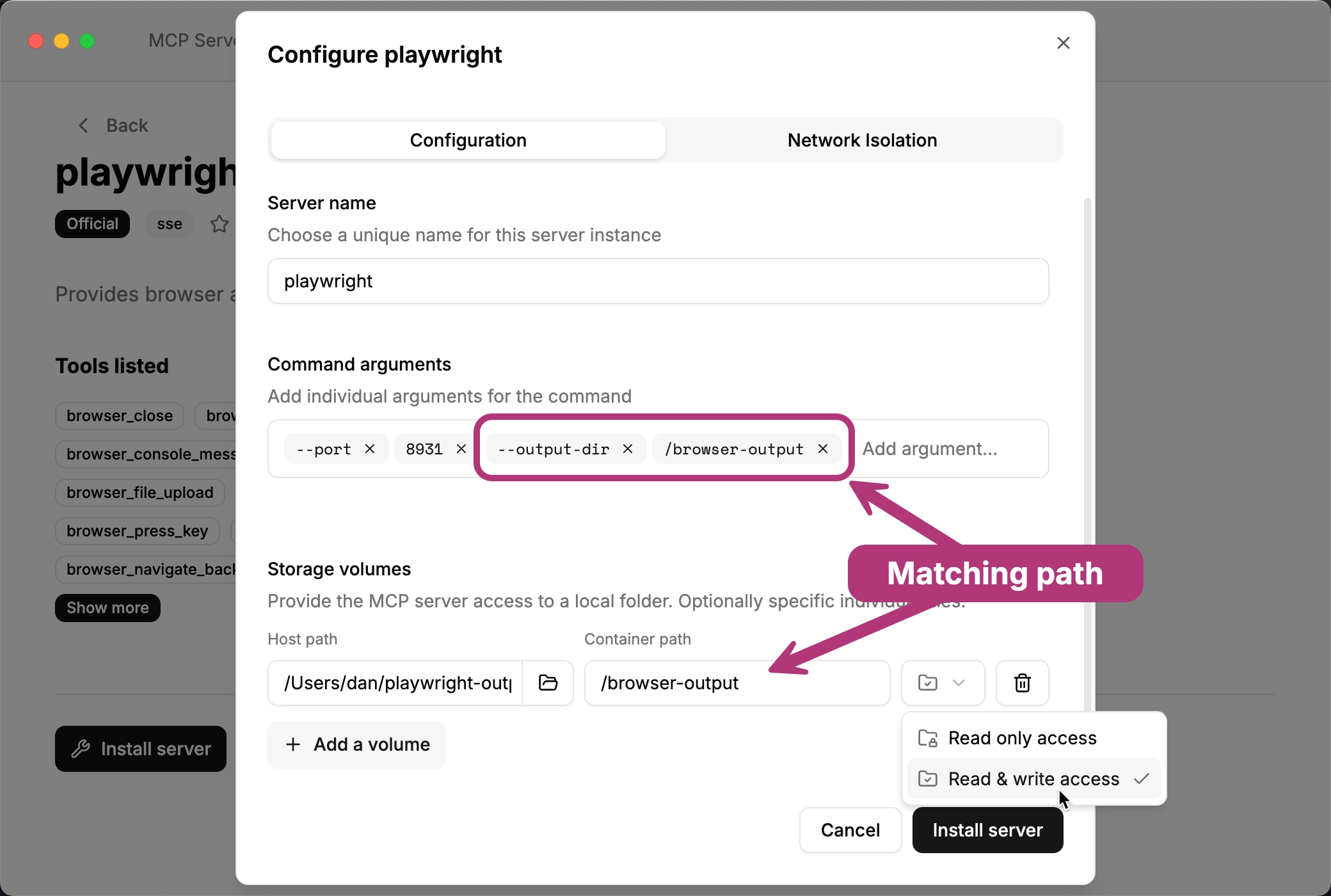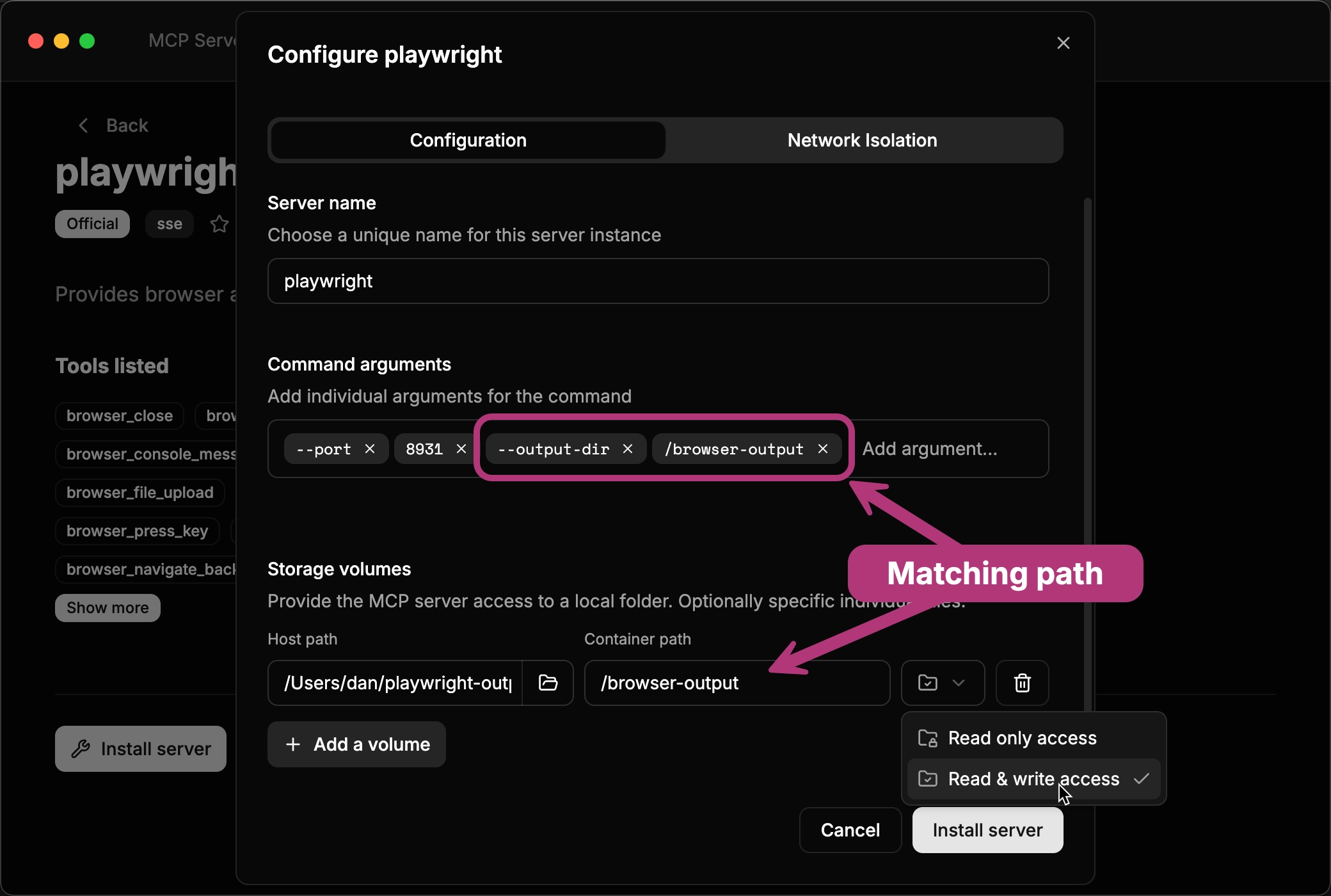Playwright MCP server guide
Overview
The official Playwright MCP server provides browser automation capabilities using Playwright. This server enables AI agents to interact with web pages through structured accessibility snapshots, bypassing the need for screenshots or visually-tuned models.
Key features include:
- Fast and lightweight: Uses Playwright's accessibility tree instead of pixel-based input
- LLM-friendly: Operates purely on structured data without requiring vision models
- Deterministic tool application: Avoids ambiguity common with screenshot-based approaches
- Multi-browser support: Works with Chrome, Firefox, Safari (WebKit), and Edge
- Tab management: Create, switch between, and manage multiple browser tabs
- Persistent sessions: Maintains login state and browser data between interactions
Metadata
Expand to view the MCP server's metadata
Name: playwright
Type: container
Description: Provides browser automation capabilities using Playwright
Tier: Official
Status: Active
Transport: stdio
Image: mcr.microsoft.com/playwright/mcp:v0.0.52
Has Provenance: No
Permissions:
Network:
Insecure Allow All: true
Allow Port: 443
Repository URL: https://github.com/microsoft/playwright-mcp
Popularity: 23762 stars, 23622 pulls
Last Updated: 2025-11-30T02:39:10Z
Tools:
- browser_click
- browser_close
- browser_console_messages
- browser_drag
- browser_evaluate
- browser_file_upload
- browser_fill_form
- browser_handle_dialog
- browser_hover
- browser_install
- browser_navigate
- browser_navigate_back
- browser_network_requests
- browser_press_key
- browser_resize
- browser_run_code
- browser_select_option
- browser_snapshot
- browser_tabs
- browser_take_screenshot
- browser_type
- browser_wait_for
Tags:
playwright, automation, browser, navigate, testing, web, accessibility
Example Command:
thv run playwright
Usage
The Playwright MCP server supports numerous command-line arguments to customize its behavior. Common options include:
- Custom viewport: Set
--viewport-sizeto specify browser dimensions (e.g.,1920,1080) - Device emulation: Use
--deviceto emulate mobile devices (e.g.,"iPhone 15") - Network isolation: Configure
--allowed-originsand--blocked-originsto control which websites the browser can access - Output directory: Specify
--output-dirto save screenshots, PDFs, and other files to a custom location; mount a host directory for persistence (see examples below)
Refer to the Playwright MCP server documentation for the full list of configuration options and their descriptions.
The containerized version of Playwright only supports the Chromium browser in headless mode.
- UI
- CLI
- Kubernetes
Select the playwright MCP server in the ToolHive registry. The server runs
with default settings that work for most use cases.
To customize the server's behavior, add command-line arguments in the Command arguments section.
To save browser output files like screenshots and traces, mount a host directory
in the Storage volumes section and add the --output-dir <container-path>
command argument as shown in the screenshot below.


Run with the default configuration using Chromium in headless mode:
thv run playwright
Emulate a mobile device for responsive testing:
thv run playwright -- --device "iPhone 15"
Restrict access to specific domains:
thv run playwright -- --allowed-origins "example.com;trusted-site.com"
Mount a host directory (e.g., ~/playwright-output) to save browser output
files like screenshots and traces:
mkdir ~/playwright-output
thv run \
--volume ~/playwright-output:/browser-output playwright \
-- --output-dir /browser-output --save-trace --save-session
You can run multiple instances of the server with different configurations by giving each a unique name:
thv run --name playwright-desktop playwright \
-- --device "Desktop Chrome" --viewport-size 1920,1080
thv run --name playwright-iphone playwright \
-- --device "iPhone 15"
Create a basic Kubernetes manifest to deploy the Playwright MCP server using the Streamable HTTP transport:
apiVersion: toolhive.stacklok.dev/v1alpha1
kind: MCPServer
metadata:
name: playwright
namespace: toolhive-system
spec:
image: mcr.microsoft.com/playwright/mcp:v0.0.51
transport: streamable-http
mcpPort: 8931
proxyPort: 8080
args:
- '--port'
- '8931'
- '--allowed-hosts'
- '*'
Don't remove the --port 8931 or --allowed-hosts "*" arguments. They are
required to run the server using Streamable HTTP.
Apply the manifest to your Kubernetes cluster:
kubectl apply -f playwright.yaml
For production deployments with network restrictions, add the
--allowed-origins argument with a list of trusted domains:
apiVersion: toolhive.stacklok.dev/v1alpha1
kind: MCPServer
metadata:
name: playwright
namespace: toolhive-system
spec:
image: mcr.microsoft.com/playwright/mcp:v0.0.51
transport: streamable-http
mcpPort: 8931
proxyPort: 8080
args:
- '--port'
- '8931'
- '--allowed-hosts'
- '*'
- '--allowed-origins'
- 'example.com;trusted-domain.org'
Mount a persistent volume to save browser output files like screenshots and traces:
apiVersion: toolhive.stacklok.dev/v1alpha1
kind: MCPServer
metadata:
name: playwright
namespace: toolhive-system
spec:
image: mcr.microsoft.com/playwright/mcp:v0.0.51
transport: streamable-http
mcpPort: 8931
proxyPort: 8080
args:
- '--port'
- '8931'
- '--allowed-hosts'
- '*'
- '--output-dir'
- '/browser-output'
- '--save-trace'
- '--save-session'
podTemplateSpec:
spec:
volumes:
- name: playwright-output
persistentVolumeClaim:
claimName: playwright-output-claim
containers:
- name: mcp
volumeMounts:
- mountPath: /browser-output
name: playwright-output
readOnly: false
Sample prompts
Here are some sample prompts you can use to interact with the Playwright MCP server:
- "Navigate to https://toolhive.dev and take a screenshot of the homepage"
- "Go to the login page, fill in the username field with 'testuser' and password field with 'password123', then click the login button"
- "Open https://news.ycombinator.com and get the titles of the top 5 stories"
- "Navigate to a form on https://httpbin.org/forms/post, fill it out with sample data, and submit it"
- "Go to https://github.com/microsoft/playwright and check if there are any console errors on the page"
- "Take a full-page screenshot of https://example.com and save it as 'homepage.png'"
- "Navigate to an e-commerce site, search for 'laptop', and capture information about the first product"
- "Open multiple tabs, navigate to different websites in each, and then switch between them"
Recommended practices
- Use accessibility-first interactions: The server works best when you describe elements by their accessible names, labels, or text content rather than visual characteristics.
- Leverage browser profiles: For workflows requiring authentication, use persistent profiles or storage state files to maintain login sessions.
- Enable network restrictions: Use
--allowed-originsand--blocked-originsto limit which domains the browser can access, especially in production environments. - Monitor resource usage: Browser automation can be resource-intensive; consider using headless mode and limiting concurrent sessions.
- Handle dynamic content: Use the
browser_wait_fortool when dealing with content that loads asynchronously. - Organize output files: Specify a custom output directory to keep screenshots, PDFs, and traces organized.
- Test responsively: Use device emulation to test how web applications behave on different screen sizes and devices.